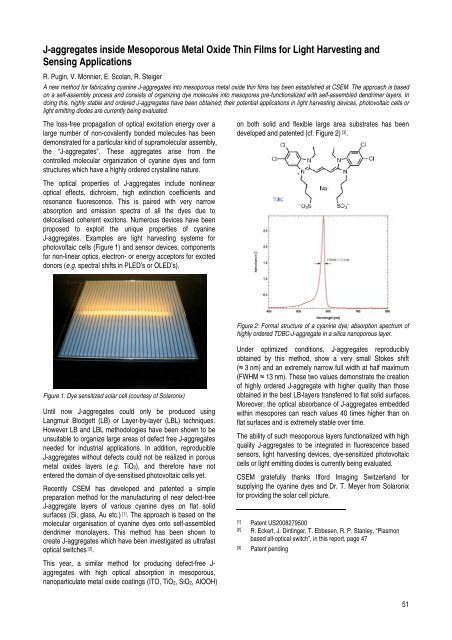CSEM Scientific and Technical Report 2008
CSEM Scientific and Technical Report 2008
CSEM Scientific and Technical Report 2008
Create successful ePaper yourself
Turn your PDF publications into a flip-book with our unique Google optimized e-Paper software.
J-aggregates inside Mesoporous Metal Oxide Thin Films for Light Harvesting <strong>and</strong><br />
Sensing Applications<br />
R. Pugin, V. Monnier, E. Scolan, R. Steiger<br />
A new method for fabricating cyanine J-aggregates into mesoporous metal oxide thin films has been established at <strong>CSEM</strong>. The approach is based<br />
on a self-assembly process <strong>and</strong> consists of organizing dye molecules into mesopores pre-functionalized with self-assembled dendrimer layers. In<br />
doing this, highly stable <strong>and</strong> ordered J-aggregates have been obtained; their potential applications in light harvesting devices, photovoltaic cells or<br />
light emitting diodes are currently being evaluated.<br />
The loss-free propagation of optical excitation energy over a<br />
large number of non-covalently bonded molecules has been<br />
demonstrated for a particular kind of supramolecular assembly,<br />
the “J-aggregates”. These aggregates arise from the<br />
controlled molecular organization of cyanine dyes <strong>and</strong> form<br />
structures which have a highly ordered crystalline nature.<br />
The optical properties of J-aggregates include nonlinear<br />
optical effects, dichroism, high extinction coefficients <strong>and</strong><br />
resonance fluorescence. This is paired with very narrow<br />
absorption <strong>and</strong> emission spectra of all the dyes due to<br />
delocalised coherent excitons. Numerous devices have been<br />
proposed to exploit the unique properties of cyanine<br />
J-aggregates. Examples are light harvesting systems for<br />
photovoltaic cells (Figure 1) <strong>and</strong> sensor devices, components<br />
for non-linear optics, electron- or energy acceptors for excited<br />
donors (e.g. spectral shifts in PLED’s or OLED’s).<br />
Figure 1: Dye sensitized solar cell (courtesy of Solaronix)<br />
Until now J-aggregates could only be produced using<br />
Langmuir Blodgett (LB) or Layer-by-layer (LBL) techniques.<br />
However LB <strong>and</strong> LBL methodologies have been shown to be<br />
unsuitable to organize large areas of defect free J-aggregates<br />
needed for industrial applications. In addition, reproducible<br />
J-aggregates without defects could not be realized in porous<br />
metal oxides layers (e.g. TiO2), <strong>and</strong> therefore have not<br />
entered the domain of dye-sensitised photovoltaic cells yet.<br />
Recently <strong>CSEM</strong> has developed <strong>and</strong> patented a simple<br />
preparation method for the manufacturing of near defect-free<br />
J-aggregate layers of various cyanine dyes on flat solid<br />
surfaces (Si, glass, Au etc.) [1] . The approach is based on the<br />
molecular organisation of cyanine dyes onto self-assembled<br />
dendrimer monolayers. This method has been shown to<br />
create J-aggregates which have been investigated as ultrafast<br />
optical switches [2] .<br />
This year, a similar method for producing defect-free Jaggregates<br />
with high optical absorption in mesoporous,<br />
nanoparticulate metal oxide coatings (ITO, TiO2, SiO2, AlOOH)<br />
on both solid <strong>and</strong> flexible large area substrates has been<br />
developed <strong>and</strong> patented (cf. Figure 2) [3] .<br />
Figure 2: Formal structure of a cyanine dye; absorption spectrum of<br />
highly ordered TDBC-J-aggregate in a silica nanoporous layer.<br />
Under optimized conditions, J-aggregates reproducibly<br />
obtained by this method, show a very small Stokes shift<br />
(≈ 3 nm) <strong>and</strong> an extremely narrow full width at half maximum<br />
(FWHM ≈ 13 nm). These two values demonstrate the creation<br />
of highly ordered J-aggregate with higher quality than those<br />
obtained in the best LB-layers transferred to flat solid surfaces.<br />
Moreover, the optical absorbance of J-aggregates embedded<br />
within mesopores can reach values 40 times higher than on<br />
flat surfaces <strong>and</strong> is extremely stable over time.<br />
The ability of such mesoporous layers functionalized with high<br />
quality J-aggregates to be integrated in fluorescence based<br />
sensors, light harvesting devices, dye-sensitized photovoltaic<br />
cells or light emitting diodes is currently being evaluated.<br />
<strong>CSEM</strong> gratefully thanks Ilford Imaging Switzerl<strong>and</strong> for<br />
supplying the cyanine dyes <strong>and</strong> Dr. T. Meyer from Solaronix<br />
for providing the solar cell picture.<br />
[1] Patent US<strong>2008</strong>279500<br />
[2] R. Eckert, J. Dintinger, T. Ebbesen, R. P. Stanley, “Plasmon<br />
based all-optical switch”, in this report, page 47<br />
[3] Patent pending<br />
51








